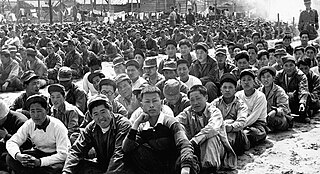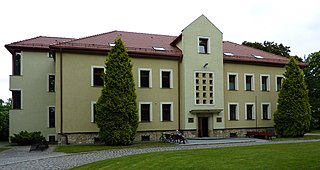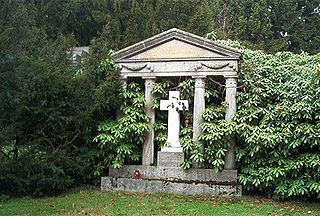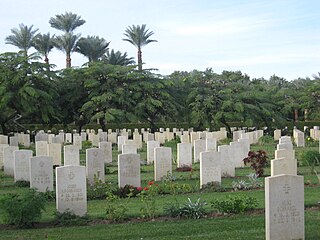
The Eastern Front or Eastern Theater of World War I was a theater of operations that encompassed at its greatest extent the entire frontier between Russia and Romania on one side and Austria-Hungary, Bulgaria, Ottoman, and Germany on the other. It stretched from the Baltic Sea in the north to the Black Sea in the south, involved most of Eastern Europe, and stretched deep into Central Europe as well. The term contrasts with "Western Front", which was being fought in Belgium and France.

A prisoner-of-war camp is a site for the containment of enemy fighters captured by a belligerent power in time of war.

Schoonselhof Cemetery is located in Hoboken, Antwerp, a suburb of Antwerp, Belgium.

Sir Robert Stodart Lorimer, KBE was a prolific Scottish architect and furniture designer noted for his sensitive restorations of historic houses and castles, for new work in Scots Baronial and Gothic Revival styles, and for promotion of the Arts and Crafts movement.

El Qantara is a northeastern Egyptian city on both sides of the Suez Canal, in the Egyptian governorate of Ismailia, 160 kilometres (99 mi) northeast of Cairo and 50 kilometres (31 mi) south of Port Said. The two parts of the city are connected by a high-level fixed road bridge, the Mubarak Peace Bridge. The bridge makes a connection between the division of Africa, and Asia, making El Qantara a Border town.

Łambinowicepronounced ['wambinɔˈvit͡sɛ] is a village in Nysa County, Opole Voivodeship, in south-western Poland. It is the seat of the gmina called Gmina Łambinowice. It lies approximately 17 kilometres (11 mi) north-east of Nysa and 31 km (19 mi) south-west of the regional capital Opole.
The German War Graves Commission is responsible for the maintenance and upkeep of German war graves in Europe and North Africa. Its objectives are acquisition, maintenance and care of German war graves; tending to next of kin; youth and educational work; and preservation of the memory to the sacrifices of war and despotism. Former head of the Bundeswehr Wolfgang Schneiderhan was elected President of the organisation in 2016, succeeding SPD politician Markus Meckel. The President of Germany, currently Frank-Walter Steinmeier (SPD), is the organisation's patron.

Milovice is a town in Nymburk District in the Central Bohemian Region of the Czech Republic. It has about 12,000 inhabitants.

The situation of World War I prisoners of war in Germany is an aspect of the conflict little covered by historical research. However, the number of soldiers imprisoned reached a little over seven million for all the belligerents, of whom around 2,400,000 were held by Germany.

The Canadian Siberian Expeditionary Force was a Canadian military force sent to Vladivostok, Russia, during the Russian Revolution to bolster the allied presence, oppose the Bolshevik Revolution and attempt to keep Russia in the fight against Germany. Composed of 4,192 soldiers and authorized in August 1918, the force returned to Canada between April and June 1919. The force was commanded by Major General James H. Elmsley. During this time, the C.S.E.F. saw little fighting, with fewer than 100 troops proceeding "up country" to Omsk, to serve as administrative staff for 1,500 British troops aiding the anti-Bolshevik White Russian government of Admiral Alexander Kolchak. Most Canadians remained in Vladivostok, undertaking routine drill and policing duties in the volatile port city.

Blauwepoort Farm is a Commonwealth War Graves Commission burial ground for the dead of the First World War located near Ypres in Belgium on the Western Front.

Ohlsdorf Cemetery in the Ohlsdorf quarter of the city of Hamburg, Germany, is the biggest rural cemetery in the world and the fourth-largest cemetery in the world. Most of the people buried at the cemetery are civilians, but there is also a large number of victims of war from various nations. The cemetery notably includes the Old Hamburg Memorial Cemetery with the graves of many notable Hamburg citizens.
Rusthof cemetery is located at the Dodeweg 31 in Leusden, the Netherlands. It is the largest cemetery that services the nearby town of Amersfoort.

Dietkirchen an der Lahn is a borough (Ortsbezirk) of Limburg an der Lahn, seat of the district of Limburg-Weilburg in the state of Hesse, Germany. The formerly independent village was incorporated into Limburg in 1971. The town is dominated by the basilica St. Lubentius, which was the most important early-medieval church building in the region.

Camp Quedlinburg was a prisoner-of-war camp located 2 kilometers north of Quedlinburg, Germany, during the First World War. It was built in September 1914. From 1914 to 1922, the camp housed 12,000 to 18,000 prisoners of war on average. Around 27,000 people lived in the neighbouring city of Quedlinburg at that time. There were three official branch offices in Staßfurt, Atzendorf and Aschersleben as well as other unofficial offices in Egeln, Halberstadt, Schönebeck, Groß Rodensleben, Schadeleben and Hedersleben.

Fayed is a city in the Ismailia Governorate, Egypt. Its population was estimated at about 32,500 people in 2018. The town is located about 20 kilometers south of Ismailia on the western shore of the Great Bitter Lake. It is located about halfway along the Suez Canal.

The Arnsberg Forest massacre was a series of mass extrajudicial killings of 208 forced labourers and POWs (Ostarbeiter), mainly of Russian and Polish descent, by Nazi troops under the command of Hans Kammler from 20 to 23 March 1945.
During World War I (1914–1918), Wales was part of the United Kingdom of Great Britain and Ireland, which entered the war in August 1914 as one of the Entente Powers, along with France and Russia. In part as an effect of chain ganging, the UK decided due to geopolitical power issues to declare war on the Central Powers, consisting of Germany, Austria-Hungary, the Ottoman Empire, and Bulgaria.

















